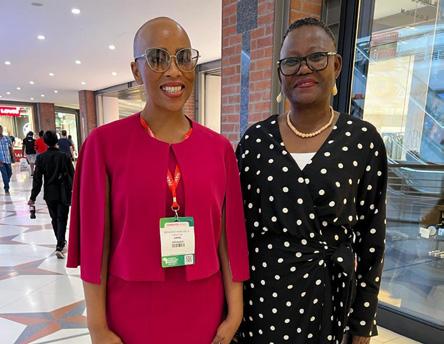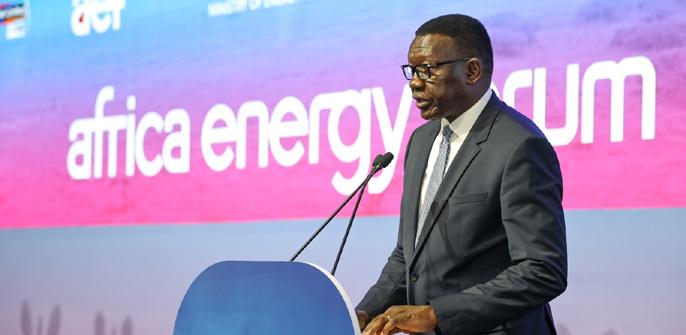
5 minute read
POWERING THE FUTURE
from theTradeEnvoy
The Democratic Republic of Congo (DRC) is renowned for its mining potential, boasting over 1,100 distinct mineral substances.
Speaking at the Mining Indaba 2023, DRC’s President Felix Tshisekedi invited foreign investors to contribute to local communities that have been extensively impacted by mining activities.
Advertisement
However, he re-emphasized his vision of local industries participating in the processing of mining products, enabling African populations to benefit more significantly from the wealth of their subsoil.
“The mining sector in the Democratic Republic of Congo can only be profitable for you, the investors, if it responds to the aspirations of the local communities affected by the mining projects. It is within this exact context that revenue redistribution mechanisms have been incorporated into my country’s legislation, for the benefit of the populations impacted by mining projects,” stated President Tshisekedi.
Tshisekedi also expressed his intention to attract investors for cobalt and lithium processing in the country. He confirmed that exploration for two minerals - nickel and chrome - will commence in the coming days in Congo’s southern, diamond-rich Kasai region. He reassured that measures had been implemented to manage the security situation and assist the Congolese in benefiting from their country’s mineral resources through rational exploitation.
The Strategic Role of DRC’s Cobalt in the Global Energy Transition
The Democratic Republic of Congo (DRC) is at the center of a global shift towards renewable energy sources and sustainable technologies, thanks to its rich Cobalt reserves. In 2020 alone, DRC’s Cobalt production amounted to 90,000 tons, which represented an impressive 41 percent of the world’s Cobalt supply. This blue metallic element is a critical component in the manufacturing of lithium-ion batteries, which are ubiquitous in modern electronics such as smartphones, laptops, and most importantly, electric vehicles (EVs).
Driving the Electric Vehicle Industry
As the world moves closer towards achieving its net-zero carbon emission goals, the demand for clean, renewable energy sources is set to grow exponentially. As such, Cobalt, a crucial element in the production of rechargeable batteries powering this green revolution, is primed for an unprecedented surge in demand.
The electric vehicle industry, in particular, is one sector where the significance of Cobalt cannot be overstated. As traditional petroleum-fueled vehicles fall out of favor due to their high carbon emissions, EVs are quickly emerging as a sustainable alternative. Given their reliance on high-capacity rechargeable batteries, the production of EVs is directly linked to the availability of Cobalt.
According to industry forecasts, the electric vehicle market is expected to experience substantial growth over the coming years. By the end of 2023, the EV market is projected to sell around 14 million units. If achieved, this figure would account for a significant portion of the total cars globally. Given that each electric vehicle requires a substantial amount of Cobalt for its lithium-ion battery, the projected growth of the EV market underscores the strategic importance of DRC’s Cobalt reserves.
Key Statistics on Cobalt Demand
The global Cobalt market size was estimated at USD 5.48 billion in 2020 and is expected to grow at a compound annual growth rate (CAGR) of 12.8% from 2021 to 2028, according to a report by Grand View Research. This impressive growth is primarily driven by the rising demand for lithium-ion batteries in electric vehicles and various consumer electronics.
According to a study by ResearchAndMarkets.com, the global market for lithium-ion batteries is set to reach $129.3 billion by 2027, growing at a CAGR of 18.0% over the analysis period 2020-2027. The lithium cobalt oxide segment, which currently accounts for a 26.2% share of the global lithiumion battery market, is expected to maintain a 16.5% growth momentum through this period.
Such projections give an insight into the significance of the DRC’s Cobalt reserves in the energy transition and sustainability efforts. As one of the most important suppliers of this mineral, the DRC is in a strategic position to influence the renewable energy market and capitalize on the rising global demand for electric vehicles.
Challenges and Opportunities
However, capitalizing on this opportunity is not without its challenges. The mining industry in DRC, including Cobalt extraction, has been criticized for its human rights issues, including child labor and poor working conditions. It is imperative for the DRC and the mining companies operating within its borders to ensure that Cobalt is sourced responsibly and ethically.
The DRC government is committed to taking steps to ensure that its people benefit from the Cobalt wealth. This includes implementing policies that promote economic development, such as investing in infrastructure, education, and healthcare. At the same time, strengthen its partnerships with international partners to ensure that the mining industry operates in a manner that is environmentally sustainable.
According to a study by ResearchAndMarkets.com, the global market for lithium-ion batteries is set to reach $129.3 billion by 2027, growing at a CAGR of 18.0% over the analysis period 20202027. The lithium cobalt oxide segment, which currently accounts for a 26.2% share of the global lithium-ion battery market, is expected to maintain a 16.5% growth momentum through this period.

Despite these challenges, the DRC’s Cobalt reserves present an exciting opportunity for the country’s economic growth and development. Successfully leveraging this opportunity would not only transform the nation’s economy but also position it as a strategic player in the global green energy transition.
Future Projections and Implications
Market analysts forecast that by 2030, more than half of all new car sales and a third of the global fleet—equal to 559 million vehicles— will be electric. Such an immense expansion of the EV market indicates a corresponding rise in Cobalt demand. For DRC, this could mean increased revenues, potential job growth in the mining sector, and international partnerships and investments opportunities.
At the same time, this anticipated boom in Cobalt demand could drive innovation and research into more efficient and sustainable mining techniques. Such developments would not only improve the sector’s environmental footprint but could also lead to improved working conditions and practices.
It is also important to consider the potential impact of this booming demand for Cobalt on global commodity markets. As demand grows and supplies become increasingly strained, we may witness significant price volatility for Cobalt, which could impact the economic dynamics of producing countries like the DRC.
DRC’s Role in Sustainable Development
Looking beyond the economic implications, the DRC’s Cobalt reserves could also play a key role in achieving global sustainable development goals. As the world transitions towards cleaner energy, the demand for Cobalt-powered lithium-ion batteries could spur significant investment in renewable energy technologies, contributing to a global reduction in carbon emissions.
By tapping into its Cobalt wealth, the DRC has the opportunity to position itself as a leader in the green energy transition. However, it will be crucial for the DRC to manage this resource responsibly, ensuring that the benefits of its Cobalt wealth are shared equitably among its citizens while also meeting international ethical and environmental standards.
In conclusion, the DRC’s Cobalt reserves hold great potential for driving the global shift towards renewable energy, particularly in the burgeoning electric vehicle industry. Harnessing this opportunity will require concerted efforts from the DRC government, mining companies, and international partners to navigate the associated challenges and ensure that this resource brings sustainable, long-term benefits to the country and its people. As we look to the future, the strategic role of DRC’s Cobalt in the global energy transition becomes increasingly clear, reinforcing the country’s importance in our sustainable future.










